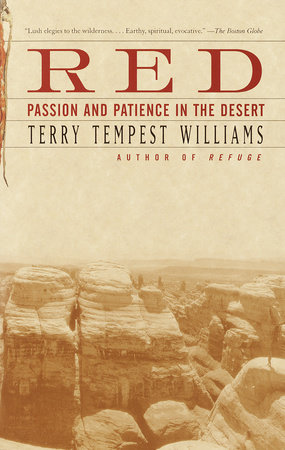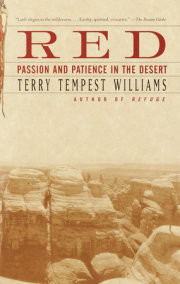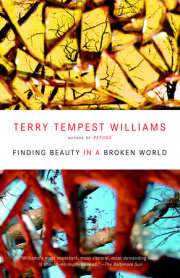from Chapter 1
Home Work
It is a simple equation: place + people = politics. In the American West, the simplicity becomes complicated very quickly as abstractions of philosophy and rhetoric turn into ground scrimmages--whether it's over cows grazing on public lands, water rights, nuclear waste dumps in the desert, the creation of the Grand Staircase Escalante National Monument, or the designation of wilderness. This territory is not neutral. The redrock desert and canyon country of southern Utah provokes powerful divisive opinions.
How are we to find our way toward conversation?
For me, the answer has always been through story. Story bypasses rhetoric and pierces the heart. Story offers a wash of images and emotion that returns us to our highest and deepest selves, where we remember what it means to be human, living in place with our neighbors.
I came to the stories in Coyote's Canyon through a question: "What stories do we tell that evoke a sense of place?" I had just finished a long inquiry into Navajo oral tradition and had been working on the reservation in various public schools. It was clear to me, both the elders and children alike had deep ties to the land through story. Whether it was Shiprock, Window Rock, or the ruins at Hovenweep, each landform, each significant site, seemed to have a name accompanied by a story. The stories they told animated the country, made the landscape palpable and the people accountable to the health of the land, its creatures, and each other. This is not to romanticize the Dine (as they call themselves), only to voice my profound respect for their intricate and complex cosmology.
How do the stories we tell about ourselves in relationship to place shape our perceptions of place? Is there room for a retelling of our own creation stories, even Genesis?
In the Colorado Plateau--roughly the Four Corners region of Utah, Colorado, New Mexico, and Arizona--I believe we are in the process of creating our own mythology, a mythology born out of this spare, raw, broken country, so frightfully true, complex, and elegant in its searing simplicity of form. You cannot help but be undone by its sensibility and light, nothing extra. Before the stillness of sandstone cliffs, you stand still, equally bare.
These redrock canyons in southern Utah are an acquired taste. They are short on water and, as a result, short on green. Green recalls pastoral comfort, provides a resting place for the eyes. There are moments when I long for the canopy and cover of a forest to hide in, to breathe in, to breathe with, and delight in the growing shades and patterns of green. I never forget I inhabit the desert, the harsh, brutal beauty of skin and bones.
Although we have mountains here of extraordinary stature and elevations--the LaSals in particular, rising to twelve thousand feet--the high points of excursions into the Colorado Plateau are usually points of descent. Down canyons. Down rivers. Down washes left dry, scoured, and sculpted by sporadic flash floods.
It's tough country to visit. It's even tougher country to live in. So powerful is the sun in summer, one adopts a perpetual squint. Summer can bring biblical periods of forty days of heat well over one hundred degrees, reducing you to a lizard state of mind, no thought and very little action. You sleep more and you dream. It is a landscape of extremes. You learn sooner or later to find an equilibrium within yourself; otherwise, you move.
Desert as teacher.
Desert as mirage.
Desert as illusion, largely our own.
What you come to see on the surface is not what you come to know. Emptiness in the desert is the fullness of space, a fullness of space that eliminates time. The desert is time, exposed time, geologic time. One needs time in the desert to see.
As the world becomes more crowded and corroded by consumption and capitalism, this landscape of minimalism will take on greater significance, reminding us through its bloodred grandeur just how essential wild country is to our psychology, how precious the desert is to the soul of America.
These lands have been here for millions of years, and they will certainly outlast us by another million years or more. But they will not remain ecologically intact without our vigilance, without our willingness to protect what is wild.
Those of us who live here know the heartbreak of loss. Since the construction of the Glen Canyon Dam, which shunted the flow of the Colorado River on its way toward the Grand Canyon in the 1950s, as residents of the Desert West, we have learned wildness cannot be taken for granted. It's not just the loss of a "playground" or a place of recreation, as many opponents would argue; it's the fundamental loss of natural systems, free-flowing rivers, rock art pecked and painted into stone by the hands of the Ancient Ones a thousand years ago. It is the drowning of a way of life, the death of natural communities that are much older, and perhaps wiser, than those of our own species.
Most lands in the American West are public lands, a commons if you will, held inside a national trust: national forests, Bureau of Land Management lands, national parks, monuments, and refuges. Only a small portion of our lands are privately owned, 22 percent in the state of Utah. Our character is shaped by the rugged truth of indifference--mountain ranges and arid basins, sagebrush oceans, grasslands, high deserts and plateaus, wild and raging rivers. It's hard to take yourself very seriously when confronted face-to-face with a mountain lion or the reality of no water in the desert. There's so much land, stretches of land so vast you cannot see it all at once, certainly not in a lifetime. We stand under the canopy of stars and are flushed with humility, stars no longer seen by most as they are erased by urban life.
The region of the American West shares common ground with the South: each has found its voice in loss. The South was forever shaped by the Civil War, and today we in the West are in the midst of our own. It is not a battle over issues of slavery. It is a battle over public and private uses of land, what will be developed and what will remain sovereign. Guns are replaced by metaphorical monkey wrenches and shovels.
In November 1999 the watchdog group Public Employees for Environmental Responsibility issued a report saying, "beatings, bombings, death threats, and other incidents against federal resource employees, largely in the West, have been steadily rising since 1995." Audubon reported in their January?February 2000 issue that "In 1998 there were almost 100 incidents in which the personnel or buildings of the U.S. Forest Service, Bureau of Land Management, and other agencies were targets of physical attack, destruction, or a direct threat of violence."
Hostilities became so great in Elko County, Nevada, that Gloria Flora resigned as supervisor of the Humboldt?Toiyabe National Forest in Nevada, the largest national forest in the lower forty-eight. She feared for the safety of her employees and wanted to shed light on the abuses. A rising star in the Forest Service, she left her post in protest in November, 1999.
In an attempt to rescue the last viable population of bull trout from extinction, Flora moved to permanently close a dirt road that had been washed out in a flood. This created a firestorm among ranchers in the community, who vowed to bulldoze a new road--one that biologists said would be detrimental to the trout. Only after a federal judge intervened with a last-minute restraining order did the locals retreat from scraping out a new road.
But the next generation of Sagebrush Rebels have not given up. On July 4, 2000, hundreds of protestors from around the West gathered in Elko to form "the Jarbidge Shovel Brigade," yet another action to defy the U.S. Forest Service. With shovels in hand, they were determined to open the Bull Trout road, now more symbolic than real. "We will rebuild the road, come hell or high water," declared Tony Lesperance, an Elko County commissioner. Following the action was a parade designed to fuel the passions of those who not only distrust the federal government but despise it for interfering in their backyard, complete with a float bearing a tombstone that read "U.S. Forest Service."
The second section of Red focuses on the idea of wildness and specifically the wilderness of southern Utah. I have added to this mix of essays, congressional testimony, newspaper clippings, and journal entries, to create both a chronology and collage for the reader, to feel the swell of a community trying to speak on behalf of wild places that are threatened by development or legislation in the United States Congress. In 1995 Representative James V. Hansen (R-Utah) and Senator Orrin Hatch (R-Utah) introduced the Utah Public Lands Management Act, which would have designated 1.7 million acres as wilderness out of 22 million acres of BLM lands. That bill was defeated in 1996 in the United States Senate.
Six months later President Clinton, on the rim of the Grand Canyon, created the Grand Staircase?Escalante National Monument through the authority of the 1906 Antiquities Act, setting aside for future posterity almost two million acres of wildlands. There are people in the state of Utah who are still infuriated by that gesture, protesting that folks in rural Utah had no voice in the process. And threats continue to be made by Republican leaders such as Dick Cheney to overturn the decision. It was no different sixty years ago, in Jackson Hole, Wyoming, when the Grand Teton National Monument was established. Federal control in the American West remains an open wound.
With the election of George W. Bush as president of the United States, Gale Norton as the secretary of interior (a protege of former secretary of interior James Watt under the Reagan administration), and Representative Jim Hansen from Utah as the powerful chairman of the Natural Resources Committee, there will be no dearth of creative and cutthroat attempts to undermine and undo much of Clinton's environmental legacy, such as the Grand Staircase-Escalante National Monument in Utah and the National Forest Roadless Area Conservation Rule that protects nearly sixty million acres of national forest in thirty-eight states, including the Tongass in southeast Alaska.
In an eight-page letter sent to President-elect Bush on December 27, 2000, Congressman Hansen wrote: "After many years of being frustrated by the Clinton administration's unreasoned and frequently absurd interpretation of law and congressional intent, I am elated at finally having the opportunity to work with your administration to correct the misguided direction the Clinton administration has taken in their attempt to manage our natural resources."
According to the January 4, 2001, issue of the Washington Post, suggestions outlined in Hansen's letter included "everything from relaxing restrictions on snowmobile use in some national parks to removing some of the national monument designations the president had given public lands in recent years."
I believe Aldo Leopold was correct when he wrote in A Sand County Almanac in 1949:
No important change in ethics was ever accomplished without an internal change in our intellectual emphasis, loyalties, affections, and convictions. The proof that conservation has not yet touched these foundations of conduct lies in the fact that philosophy and religion have not yet heard of it. In our attempt to make conservation easy, we have made it trivial.
As an American writer, I have found no subject to be as intellectually challenging as writing about wilderness. How can I convey the scale and power of these big wide-open lands to those who have never seen them, let alone to those who have? How can I learn to write out of my own experience, out of my deep love for wild country, while still maintaining a language that opens minds rather than closes them? How to write again and again from every conceivable angle to stay the hand of development? How to write as clearly as one can from the heart and still be credible?
In the middle of the Utah wilderness campaign in 1996, Mary Page Stegner sent some inspiriting words by her late husband, Wallace Stegner, about why paving the Burr Trail outside Capitol Reef National Park was a wrong-headed idea:
Why? So people coming up dammed Glen Canyon in power boats can get out of the water and make it more easily from ramp to ramp. And anyone on the fringes of that lovely stone wilderness will hear their motors ten, fifteen, twenty miles away across the garbed stone, reverberating off the Kaiparowits Cliffs, ricocheting off the Waterpocket Fold.
As there has been nothing to interrupt the silence in this desert, so there is nothing to break the view of watercourses, of cliff lines and gulch and bare bald heads and domes, so there will be nothing to intercept the view of cut and fill highway.
This road as proposed by the Utah highway commission, would be a tragedy, the dimmest of "wilderness breaking." Poverty program, public works? Yes--poverty of intelligence, poverty of imagination, poverty of sensibility. And a greater poverty for Utah's future, once that last wilderness is split, shattered, and brought down to size...
Copyright © 2001 by Terry Tempest Williams. All rights reserved. No part of this excerpt may be reproduced or reprinted without permission in writing from the publisher.










